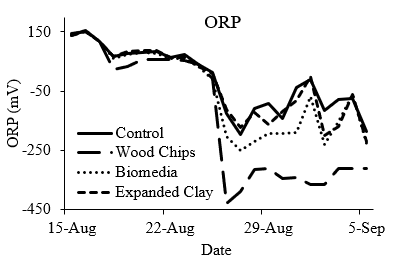EFFECT OF WOODCHIPS, BIO-BEADS, AND EXPANDED CLAY PELLETS ON DENITRIFICATION EFFICIENCY IN REUSED SHRIMP AQUACULTURE WATER
Nitrate is a key factor in limiting water reuse, particularly in marine recirculating systems , where the cost of salt makes water replacement a significant expense . Denitrification is a microbial process by which nitrate is reduced to dinitrogen gas and can be used to reduce nitrate levels in aquaculture systems. The denitrification process can be unstable and difficult to utilize in indoor shrimp production operations that are often limited in space and capital to buy and operate dedicated denitrification filters . This study examines the effectiveness of low cost, simple denitrification filters and media in discharged shrimp aquaculture effluent.
To test the different media, f our treatments were used, each with three 159 L tanks that were randomly assigned to a treatment. The treatments included plastic bio-media (BM), expanded clay pellets (EC), woodchips (WC) , and a control (CO) using no media. To hold the media, each tank had a simple denitrification reactor constructed of 10.2 cm diameter PVC pipe. The water used in the experiment came from an established L. vannamei production system with a salinity of 17 ppt and an initial nitrate concentration of 39.3 mg/l. The retention time of the reactors was maintained at 2h to maximize contact time and maintain internal DO around 1 mg/l. Carbon in the form of 10 g of sucrose was added daily to provide an exogenous electron donor critical for heterotrophic microbes . Phosphate, alkalinity, nitrite, and TAN were measured twice per week, while temperature, DO, salinity, pH, and ORP were recorded twice a day. Nitrate was sampled at the beginning of the study and end.
All four treatments, including the control showed some signs of denitrification. The project ended after 22 days when signs of denitrification (reduction in phosphate and increase in alkalinity) ceased in the WC treatment . WC showed the highest nitrate reduction of 31.6 mg/l on average , BM underwent an average reduction of 21.5 mg/l , EC reduced the nitrate by 18. 2 mg/l , and CO reduced the nitrate by 9.0 mg/l . While the control had the lowest nitrate reduction levels, some denitrification did occur, indicating that it may be possible for small-scale inland shrimp farmers to denitrify their water without the use of media. Future studies will focus on denitrification without the use of media, as well as further exploring the use of wood chips.
